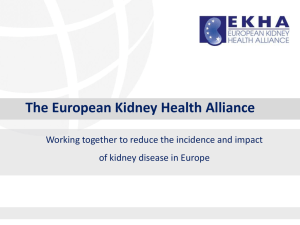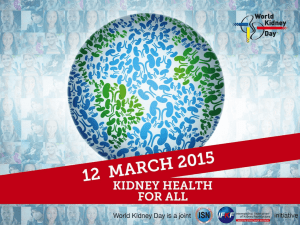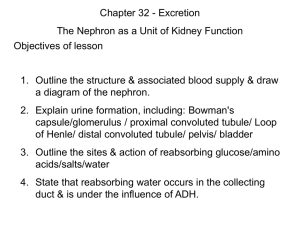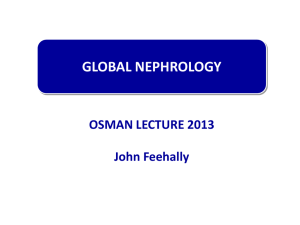Kidney Homeostasis
advertisement
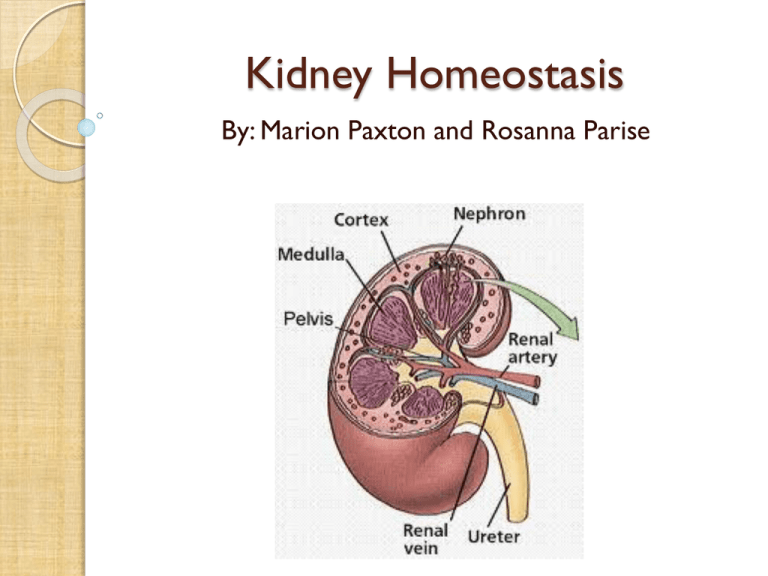
Kidney Homeostasis By: Marion Paxton and Rosanna Parise Agenda: Introduction Expectations Lesson Sequence Assessment and Evaluation Activity/Student Lab Student Misconceptions Demo Practical Applications Resources Introduction: The Kidney Main function: to filter the blood to remove waste products and to adjust salt concentrations in the blood Associated with the excretion of cellular wastes (urea, uric acid, creatinine) The Kidney Cont’d Composed of 3 sections: ◦ Outer cortex ◦ Medulla ◦ Inner pelvis Kidney Cont’d In the cortex and medulla, there are about 1,000,000 nephrons – these act as filters and are composed of: ◦ ◦ ◦ ◦ ◦ ◦ Bowman’s capsule The glomerulus Proximal tubule The loop of Henle Distal tubule Collecting duct Picture of the nephron on next slide The Kidney Nephron The Kidney Cont’d Please go to the following interactive site to learn more about the kidney: http://www.biologymad.com/resources/kidney.swf The Kidney Cont’d Homeostatic mechanisms are in place to control the levels of water and electrolytes in the blood One very important hormone involved in this is called Antidiuretic Hormone (ADH) Expectations The following are a list of expectations that will be covered through studying Kidney Homeostasis: E1.1 assess on the basis of findings from a case study, the effects on the human body of taking chemical substances to enhance performance or improve health (e.g. the risks and benefits of taking large quantities of vitamins or amino acids; the effects on the human body of substances that people use to cope with stress) E2.2 plan and construct a model to illustrate the essential components of the homeostatic process (e.g. create a flow chart that illustrates representative feedback mechanisms in living things) E2.3 plan and conduct an investigation to study a feedback system (e.g., stimulus response loop) E3.1 describe the anatomy and physiology of the endocrine, excretory, and nervous systems, and explain how these systems interact to maintain homeostasis E3.3 describe the homeostatic processes involved in maintaining water, ionic, thermal, and acid–base equilibrium, and explain how these processes help body systems respond to both a change in environment and the effects of medical treatments (e.g., the role of feedback mechanisms in water balance or thermoregulation, how the buffering system of blood maintains the body’s pH balance, the effect of medical treatments on the endocrine system, the effect of chemotherapy on homeostasis) Lesson Sequence Lesson 1: Kidney Structure and Function Lesson 2: The Nephron: Filtration and Reabsorption Lesson 3: Homeostasis: Feedback Mechanisms Lesson 4: Lab: The Physiological Effects of Coffee Lesson 5: Kidney Transplant Article and Case Study Lesson 1: Introduction to the Kidney: Structure and Function KWL Chart – have students fill in KW now and L after lesson 5 (self assessment) Intro Video: http://www.youtube.com/watch?v=qxb2_d9ilEw Group work: ◦ Provide students with basic diagram – have them fill in the name of each structure ◦ Then, they will complete a T chart on the structure and function of the following: kidney, renal veins, renal arteries, urinary bladder, urethra Lesson 2: The Kidney Nephron: Filtration and Re-absorption Teacher demo on passive transport Youtube video: http://www.youtube.com/watch?v=glu0dzK4dbU Interactive Site http://www.biologymad.com/resources/kidney.swf • Role play exercise where students are the filtrate and classroom desks are arranged as the nephron • Worksheet Lesson 2: The Kidney Nephron: Filtration and Re-absorption Lesson 3: Homeostasis: Feedback Mechanisms Introduce hormone ADH Students investigate ADH feedback loop (next slide) They come up with a way to demonstrate how ADH works to their peers Lesson 3: Homeostasis: Feedback Mechanisms Lesson 4: Lab The Physiological Effects of Coffee For this lab, students will design an experiment that allows them to investigate one physiological effect of consuming coffee (e.g. Effects on blood pressure, urine output, etc.) Refer to Word document for a more detailed description of this lab Lesson 5: Kidney Transplant Article and Case Study Students use an anticipation guide to read an article about kidney transplants in Canada. 4 corners strategy used to discuss opinions A class debate about a kidney transplant case study: Article: “Kidney transplants in Canada: unequal access” http://www.cmaj.ca/content/175/5/489.full Peer and self assessment Assessment and Evaluation Lesson 1: KWL Chart – diagnostic and form of self assessment Lesson 2: Nephron Worksheet Lesson 3: Lesson 4: Lab Report Lesson 5: Anticipation guide; peer and selfassessment Student Difficulties Difficulty: ◦ Students may have difficulty understanding how and why different substances enter and leave the kidney tubule. Rectification ◦ Have students watch the youtube video on the function of the nephron and allow students to use the interactive website to see where different substances enter and leave the nephron. ◦ Youtube video: http://www.youtube.com/watch?v=glu0dzK4dbU ◦ Interactive website: http://www.biologymad.com/resources/kidney.swf **Note: Refer to summary handout for other rectifications.** Student Difficulties cont’d Difficulty: ◦ Some students may have trouble understanding the feedback mechanism involved in controlling urine output. Rectification ◦ Use a flow chart to help students visualize the feedback mechanism. ◦ Group weaker students with stronger students during the problem solving activity. Demonstration Passive Transport Lab ◦ Students will observe passive transport of a substance across a membrane Practical Applications Effects of steroid use on kidney functioning Kidney transplants, dialysis and organ harvesting Effects of alcohol and caffeine on kidney homeostasis Chronic renal diseases Internet Websites This video shows how the kidney nephron functions in great detail. http://www.youtube.com/watch?v=glu0dzK4 dbU This is an interactive website that illustrates how different substances move through the kidney nephron and how ADH affects the concentration of urine. http://www.biologymad.com/resources/kidne y.swf Internet Websites Cont’d Article “Kidney Transplants in Canada: unequal access”. This article highlights some of the kidney transplants problems in Canada i.e. patients dying on waiting lists, transplants being ineffective if a patient waits more than 2 years and organ donation rates by region. http://www.cmaj.ca/content/175/5/489.full This website contains a free downloadable lesson plan for conducting a class debate on kidney transplants. All references are British but the lesson plan can be easily modified for Canadian students. http://www.triplescience.org.uk/search/Resource30619.aspx Internet Websites Cont’d A great place to access background information on the kidney: http://knight.noblehs.sad60.k12.me.us/content/exploringLife/text/chapter32/con cept32.2.html This textbook contains 'The Physiological Effects of Coffee Lab'. It explains the kidney functions and structure in detail, describes the role of ADH, and contains a weblink that talks about the process of hemodialysis. The textbook has a complimentary website Blake, Leesa. McGraw-Hill Ryerson Biology 12. Toronto: McGraw-Hill Ryerson, 2002. The textbook has a complimentary website: www.mcgrawhill.ca/links/biology12

